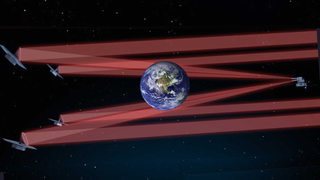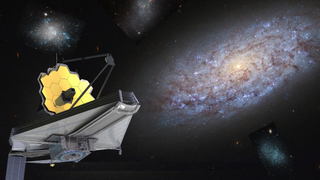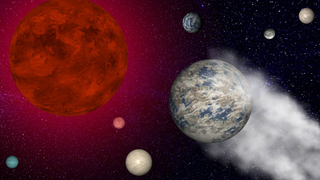
Robert Lea
Robert Lea is a science journalist in the U.K. whose articles have been published in Physics World, New Scientist, Astronomy Magazine, All About Space, Newsweek and ZME Science. He also writes about science communication for Elsevier and the European Journal of Physics. Rob holds a bachelor of science degree in physics and astronomy from the U.K.’s Open University. Follow him on Twitter @sciencef1rst.
Latest articles by Robert Lea

NASA finds clue while solving Voyager 1's communication breakdown case
By Robert Lea published
In 2023, humanity's pioneering space mission, Voyager 1, stopped sending understandable data back to Earth. Now, NASA engineers may be closer to discovering the source of the issue.

How to watch SpaceX's 3rd Starship launch test live online today
By Robert Lea last updated
SpaceX's megarocket Starship, the largest and most powerful space rocket ever built, is set for a third test flight on Thursday (March 14). You can watch it live online for free.

Scientists find black hole spaghettifying star remarkably close to Earth
By Robert Lea published
Astronomers have discovered rather close evidence of a star being ripped apart and devoured by a supermassive black hole in a tidal disruption event.

Deep-space astronomy sensor peers into the heart of an atom
By Robert Lea published
"Developed initially for space observations, the Compton Camera has now proven its worth as a tool for addressing complex scientific questions in other domains as well."

Mars attracts: How the Red Planet influences Earth's climate and seas
By Robert Lea published
Scientists have discovered a surprising 2.4-million-year-cycle in deep-sea sediments that indicates Mars has an influence on Earth's oceans and climate.

The boiling surface of giant star Betelgeuse may be creating an illusion
By Robert Lea published
Betelgeuse appears to be rotating faster than is possible for such a massive star. New research suggests this is an illusion caused by the violently boiling surface of the red supergiant.

The James Webb Space Telescope hones in on star-forming region in the Triangulum Galaxy (images)
By Robert Lea published
The James Space Telescope has used its NIRCam and MIRI instruments to capture two dynamic views of the star-forming region NGC 604 in the Triangulum Galaxy.

Some 'dead' stars hide celestial fountains of youth beneath their surfaces
By Robert Lea published
Scientists have discovered that some "dead" white dwarf stars hide a metaphorical fountain of youth beneath their skin that helps them delay their cooling processes.

Dark energy remains a mystery. Maybe AI can help crack the code
By Robert Lea published
Dark energy has humans stumped. The force is sometimes even labeled "the worst prediction in the history of physics." Can AI do any better?

Icy asteroids help the James Webb Space Telescope uncover Neptune's history
By Robert Lea published
The powerful space telescope zoomed in on Mors-Somnus, a binary pair of icy asteroids that originated within the Kuiper Belt.

If aliens had our life-hunting equipment, could they find us?
By Robert Lea published
Scientists asked the question: If Earth was an exoplanet, what would reveal it hosts life? The answer was used to verify the usefulness of a planned space mission dubbed "LIFE."

How do astronauts use the bathroom in space?
By Robert Lea published
Reference Going to the toilet is a basic human function that even astronauts, as they further human space exploration, have to undertake. So how do astronauts 'boldly go' in space.

The James Webb Space Telescope's targets over the next year include black holes, exomoons, dark energy — and more
By Robert Lea published
The James Webb Telescope will be busy during Cycle 3 , with astronomers using the powerful telescope to hunt exomoons and supermassive black holes and investigate cosmic evolution.

NASA's ice-hunting VIPER moon rover getting ready to slither to the launch pad
By Robert Lea published
NASA's VIPER moon rover is a step closer to making its lunar journey late this year: The robot's flight instruments are fully installed and the rover over 80% built.

Heaviest pair of black holes ever seen weighs 28 billion times more than the sun
By Robert Lea published
The discovery could explain why, although supermassive black hole mergers are predicted theoretically, they have never been observed in progress.

'Wiggles' of energy waves over Earth could hold the universe's history
By Robert Lea published
The CLASS telescope has mapped how microwave energy "wiggles" over Earth to learn more about the cosmic fossil that could help reveal the story of the universe.

James Webb Space Telescope reveals how stellar blasts of radiation stunt planet birth
By Robert Lea published
Using the James Webb Space Telescope, astronomers have discovered how massive stars sculpt planetary systems and stunt planet birth with bombardments of harsh radiation.

'Axion stars' that went boom after the Big Bang could shed light on dark matter
By Robert Lea published
Hypothetical particles called axions may have gathered to form "axion stars" that exploded in the early universe to create readable signals that could reveal the secrets of dark matter.

A baby star's planet-forming disk has 3 times more water than all of Earth's oceans
By Robert Lea published
Astronomers have discovered that the water content of a planet-forming disk around an infant star is enough to fill Earth's oceans three times over.

James Webb Space Telescope finds dwarf galaxies packed enough punch to reshape the entire early universe
By Robert Lea published
The James Webb Space Telescope investigated low-mass galaxies from the early universe, finding most of these dwarf galaxies' light drove a vital phase of cosmic evolution.

Possibly habitable Trappist-1 exoplanet caught destroying its own atmosphere
By Robert Lea published
"I would imagine that all Trappist-1 planets are going to have a hard time holding on to any atmosphere."

Put on your eclipse glasses and look up to see the biggest sunspot in years before it disappears from view
By Robert Lea published
The AR3590 sunspot region is the largest of the solar cycle and is responsible for the most powerful solar flare seen since 2017.

James Webb Space Telescope finds 'extremely red' supermassive black hole growing in the early universe
By Robert Lea published
Using the James Webb Space Telescope, astronomers discovered an "extremely red," growing supermassive black hole powering a quasar that existed 700 million years after the Big Bang.


